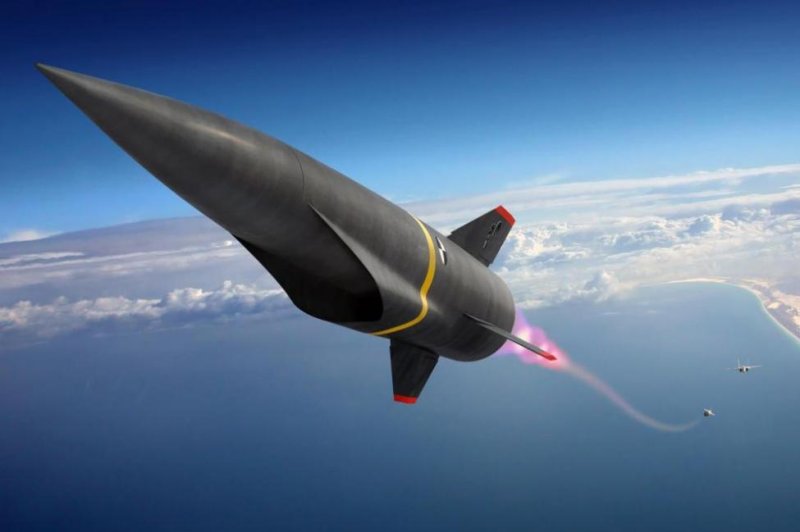This is an artist's conception of a hypersonic missile during its launch phase. Photo courtesy of Lockheed Martin
June 14 (UPI) -- For the first time, the U.S. Air Force successfully tested its hypersonic air-to-ground weapon on a B-52H Stratofortress bomber from Edwards Air Force Base, Calif.
On Wednesday, a sensor-only prototype of the AGM-183A air launched rapid response weapon, or ARRW, was carried externally by a B-52 during the test to gather environmental and aircraft handling data, the U.S. Air Force said Thursday in a news release.
Hypersonic denotes a speed of Mach 5, or five times the speed of sound or higher.
The missile prototype didn't have explosives and it was not released from the B-52 during the flight test. The Air Force did not release images of the AGM-183A.
Data were gathered on drag and vibration impacts on the weapon itself as well as the external carriage equipment of the aircraft. This type of data is required for all Air Force weapon systems undergoing development.
"We're using the rapid prototyping authorities provided by Congress to quickly bring hypersonic weapon capabilities to the warfighter," said Dr. Will Roper, assistant secretary of the Air Force for Acquisition, Technology and Logistics. "We set out an aggressive schedule with ARRW. Getting to this flight test on time highlights the amazing work of our acquisition workforce and our partnership with Lockheed Martin and other industry partners."
The ARRW is set to reach early operational capability by fiscal year 2022. Another rapid prototyping system is also being developed, the hypersonic conventional strike weapon, or HCSW. On top of this, the Air Force also is developing the hypersonic air-breathing weapon concept, or HAWC.
The B-52 will launch all three platforms.
"This type of speed in our acquisition system is essential -- it allows us to field capabilities rapidly to compete against the threats we face," Roper said.
Russia and China have also been developing hypersonic weapons, which has led the Pentagon to speed development of the munitions -- more than $1.2 billion has been earmarked through 2024 on experimental hypersonic prototypes of the weapon for the Air Force, as well as the Army and Navy.
The Drive reported the ARRW is likely an evolution of the Defense Advanced Research Project's Agency's Tactical Boost Glide effort.
In August 2018, Lockheed Martin was awarded a contract worth up to $480 million to begin designing the AGM-183A.
Then last November, Lockheed received another contract, valued at $928 million, for critical design review, test and production readiness support to facilitate fielded prototypes of the HCSW.
Last November, DARPA released proposals for the development of Glide Breaker, which is designed to intercept the hypersonic vehicles of other nations.
Raytheon in March was awarded a $63.3 million contract to further develop the tactical boost glide hypersonic weapons program, which includes the payload separating from the rocket and glides unpowered to its destination.
In 2016, Raytheon was awarded a $174 million contract for the United States for the hypersonic air-breathing weapon concept program.
The Army also plans to field combat vehicles with 50 kilowatt lasers on them sometime in 2022, Pentagon officials told reporters on June 4.















